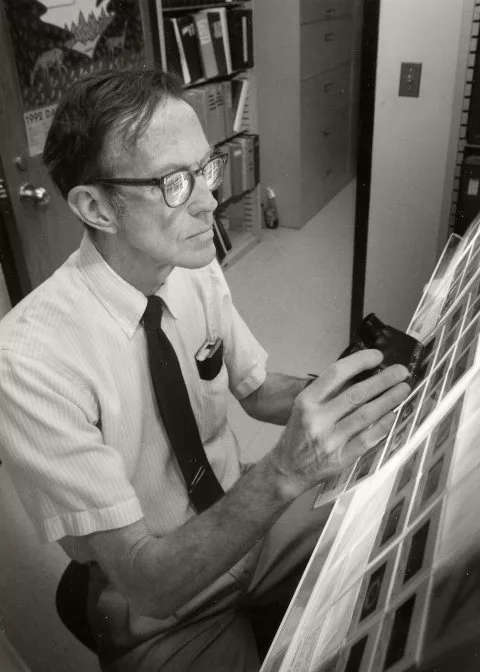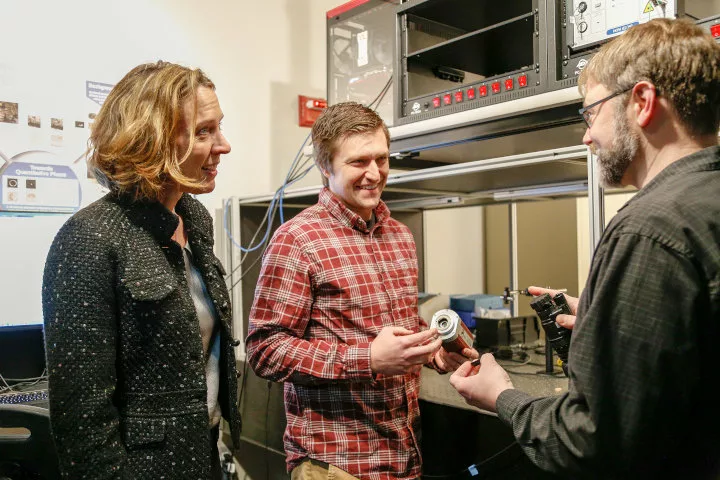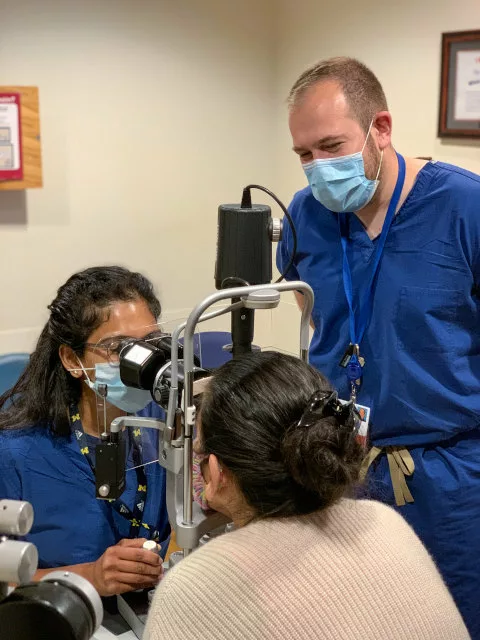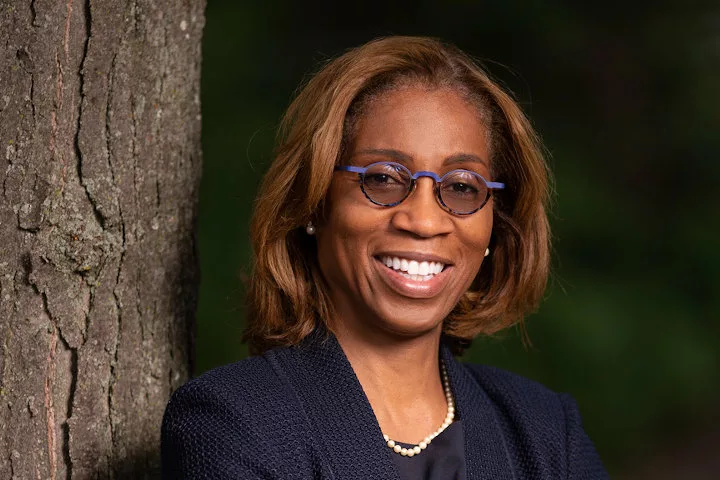Grateful Transplant Recipient Pleasant T. Rowland Gives Back to UW
A $10 million gift will support creation of the Pleasant T. Rowland Transplant Clinic, which will be located near the main entrance of University Hospital.
Saving sight looks bright when reflecting upon the 50-year history of the Department of Ophthalmology and Visual Sciences (DOVS) at the University of Wisconsin School of Medicine and Public Health (SMPH), and casting thoughts toward the next five decades.
While the 2020 celebrations reluctantly went to a virtual platform due to the COVID-19 pandemic, all agree there is much to celebrate. Today, innovations in curing and mitigating blinding diseases are commonplace. Credit is due to the department’s visionary leaders and countless contributors who have participated in this quest.
Matthew D. Davis, MD (PG ’55), formally established the department in 1970 from its beginnings as a division in the Department of Surgery. DOVS became a powerhouse in ocular imaging — starting with the standardization of evaluating retinal fundus photographs to diagnose diabetic retinopathy and various other retinal disorders, such as macular degeneration. These scientific explorations led to more effective treatments for rare and common eye conditions. Davis highly valued collaborations in clinical care and research within the department and across UW–Madison, and he attracted faculty members who embraced this approach.

The DOVS culture of translational research extends globally. For example, since 2015, faculty and staff of its Clinical Eye Research Unit and Fundus Photograph Reading Center (recently renamed the Wisconsin Reading Center) have more than doubled the number of clinical trials they oversee and industry sponsors with which they partner — worldwide — under the leadership of medical directors Mihai Mititelu, MD, MPH, associate professor, and Barbara Blodi, MD, Matthew D. Davis Professor, respectively.
“Dr. Davis’ legacy of excellence and collaboration is in our DNA, and as the department evolves over the next 50 years, we will continue to build upon this foundation,” says Terri L. Young, MD, MBA, FARVO, chair of DOVS and the Peter A. Duehr Professor of Ophthalmology, Pediatrics and Medical Genetics.
When the COVID-19 pandemic hit, Yao Liu, MD, MS, a DOVS assistant professor and UW Health glaucoma specialist — who was the department’s director of teleophthalmology and also the chair of the American Telemedicine Association Ocular Telehealth Group — was already poised to lead telemedicine efforts. DOVS teleophthalmology provides sight-saving eye-image screening services for patients close to their homes, particularly in rural Wisconsin. This technology is an example of the Wisconsin Idea in action, as well as a testament to the patient-first mentality DOVS has practiced throughout its history.
As DOVS researchers continue to develop new and improved imaging technologies, they have pursued modalities that increase the understanding of the most difficult areas of the eye to visualize. The revolutionary Wisconsin Advanced Imaging of Visual Systems (WAIVS) Project offers a noninvasive imaging technology that can assess retinal function and viability on the cellular level. The machinery — one for humans and another for animals — was built by faculty members in DOVS and other UW–Madison units, including the Morgridge Institute for Research and the McPherson Eye Research Institute, and from Stanford University. WAIVS provides high-resolution images of the retina for human clinical trials of degenerative retinal and optic nerve diseases, as well as for animal studies of ocular diseases.
“We know that WAIVS will be a key tool to capture ‘before and after’ pictures of the effects of new, experimental gene therapies and stem cell treatments to determine whether they are working, and it greatly improves the patient experience in terms of time awaiting results and overall efficacy,” says Kimberly Stepien, MD ’02, co-vice chair of DOVS clinical affairs, co-director of the Ocular Genetics Program and director of the Adult Inherited Retinal Disease Clinic.

In 2002, revolutionary stem cell therapies began in DOVS through the work of David Gamm, MD, PhD (PG ’02, ’03), professor, DOVS, and pediatric ophthalmologist, UW Health (see Quarterly, Volume 20, Number 4, 2018). Gamm also directs the McPherson Eye Research Institute, a cross-campus, interdisciplinary center founded to advance basic and translational vision research at UW–Madison. His seminal work to create fully functional retinas in Petri dishes will bring the care of patients with retinal degeneration to new levels. Clinical trials of these methodologies are in rapid development, and DOVS is poised to be one of the first programs in the country to implement them.
“In the foreseeable future — and almost certainly over the next 50 years — we will be able to offer treatment options for a number of currently irreversible blinding conditions. That is our hope and mission with pluripotent stem cell-derived treatments and other new therapeutic avenues,” notes Gamm.
The Ocular Genetics Program, which Young developed when she joined the SMPH, has attracted several faculty members, including Stepien; Melanie Schmitt, MD ’09, assistant professor, DOVS, and director, Pediatric Retinal Degeneration Program; and Bikash Patnaik, PhD, associate professor, DOVS and Department of Pediatrics, and medical director, UW Retinal Electrophysiology Program. Two genetic counselors also joined the team to evaluate patients alongside providers at the UW Health University Station Eye Clinic.
Parallel to these efforts, DOVS specialists also focus on care to enable the best possible quality of life for those who are losing, or have lost, their vision. The new Low Vision Clinic at University Station, led by Sanbrita Mondal, OD, clinical adjunct assistant professor, DOVS, evaluates the needs of visually challenged patients and connects them with invaluable resources, such as social workers, counselors and patient navigators. Mondal and her team provide instruction in adaptive equipment for activities of daily living. With financial support from the Lighthouse Guild International, Mondal trains clinical faculty, staff and health professions trainees to better assess and care for those coping with low vision or recent blindness.

Teaching the next generation of researchers and health care leaders is interwoven throughout the department’s rich history. In 2020, DOVS welcomed a new class of residents into an inaugural, four-year combined internal medicine/ophthalmology residency program based at UW Health in collaboration with the William S. Middleton Memorial Veterans Administration Hospital. DOVS also earned re-accreditation for its residency program by the Accreditation Council for Graduate Medical Education through 2030 (a 10-year award is longer than usual), and the department moved to an all-digital Grand Rounds platform.
Long-standing, annual DOVS educational events such as the Phacoemulsification Surgical Skills Course for resident training in cataract surgery, Saving Sight mini-medical school sessions for community members, and Current Concepts in Eye Care for state optometrists were converted to online options in 2020 because in-person events were not possible. The virtual formats expanded access to local DOVS communities and enhanced engagement opportunities with DOVS’ global partners in Brazil, the Philippines and India. Fostered through clinical learning exchanges and research projects, these global partnerships were developed under Young’s leadership. DOVS residents cite the two-week rotation at the Shroff’s Charity Eye Hospital in New Delhi, India, as a highlight of their training curricula, as they are able to evaluate patients with uncommon ocular conditions, learn new surgical techniques and experience a different cultural environment.
Reflecting upon the Department of Ophthalmology and Visual Sciences’ (DOVS) first 50 years at the University of Wisconsin School of Medicine and Public Health, Terri L. Young, MD, MBA, FARVO, calls 2020 — with its with major, world-shifting events — symbolic of her department’s historical demonstration of optimism, innovation and fortitude in overcoming uncertainty and challenges.

“For so many of us, our 20/20 vision was blurred by the global pandemic and social unrest,” says Young, the Peter A. Duehr Endowed Professor of Ophthalmology, Pediatrics and Medical Genetics and chair of DOVS. “Yet, our department has remained steadfast in its mission to save sight. We could not do this work without our many stakeholders and friends who inspire and support our programs.”
She continues, “As we envision our next half century, a critical front is to continue to fuel our research capabilities. We are moving forward with innovative work in big data and artificial intelligence, as examples. These efforts provide a strong milieu for enhanced learning and improved patient care.
And, Young concludes, “The DOVS’ vision to save vision remains unchanged. We are as committed as ever to building upon the department’s rich history, values and traditions.”